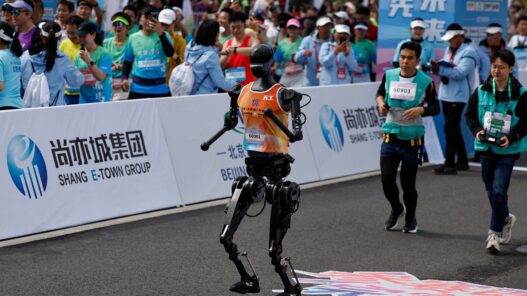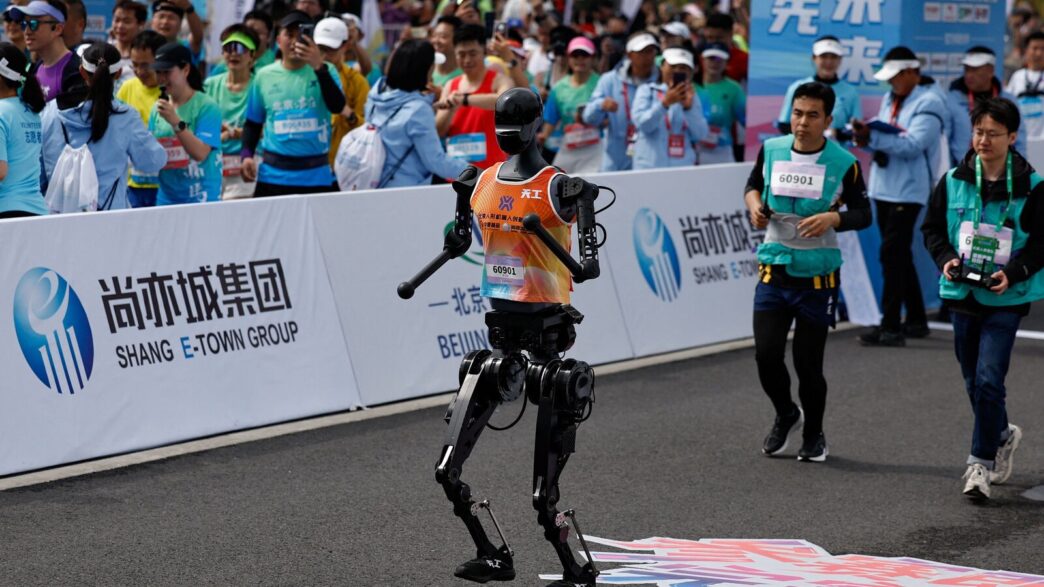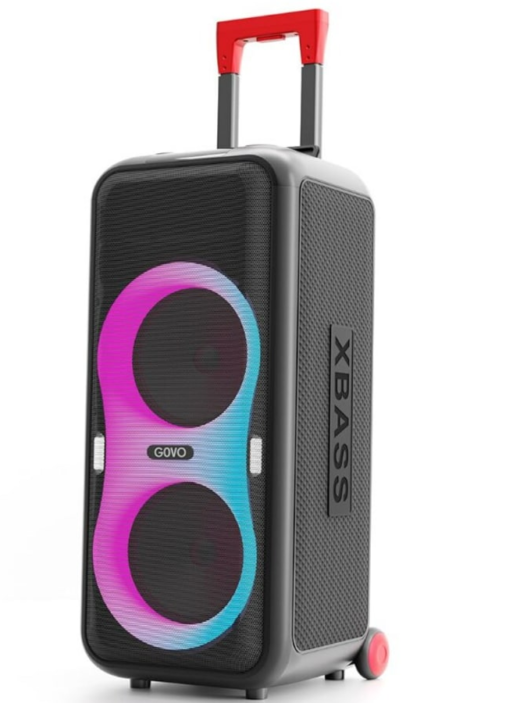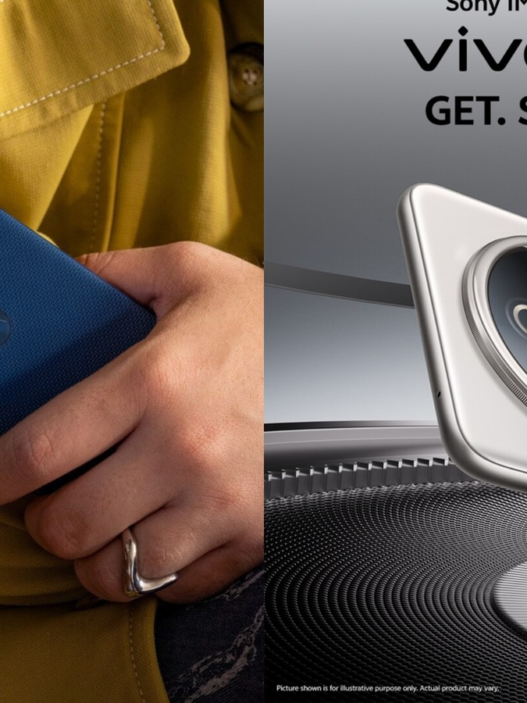At the 2012 London Paralympics, Pistorius made history by winning gold in both the men’s 400 metres and 4×100 metres relay.
While this human-machine endeavour may have rattled many, machines have also been independently outperforming humans at games. For instance, IBM’s Deep Blue beat chess grandmaster Garry Kasparov in 1996–97, and its Watson system triumphed over Jeopardy champions in 2011. Five years later, the world was stunned when AlphaGo, an AI program developed by Alphabet-owned DeepMind, defeated Go champion Lee Sedol.
Now, AI-powered machines are attempting to replicate their success by competing with humans on race tracks, too, with mixed results. While AI drones have already outpaced human pilots, driverless cars have still faltered in race conditions, and humanoid robots recently stumbled through a half-marathon in China.
Will machines eventually outrun us here too?
Two years ago, the Robotics and Perception Group at the University of Zürich became the first to beat human drone racing champions with an autonomous drone—though it happened in a controlled flight lab. These competitions offer researchers a chance to test and fine-tune their algorithms under real-world pressure.
On 14 April, an AI-powered drone from the Micro Air Vehicle Laboratory (MavLab) at Delft University of Technology outflew a world-class human pilot at the Autonomous Drone Championship. Organized by the Abu Dhabi Autonomous Racing League (A2RL) and the Drone Champions League (DCL), the AI drone raced on a highly complex track, reaching speeds up to 95.8 km/h. It triumphed over 13 autonomous competitors, including drones piloted by human champions.
However, the joy was short-lived. Just five days later, a very different picture emerged in Beijing when the E-Town tech hub hosted what was billed as the world’s first humanoid half-marathon on 19 April.
Even as 21 AI-powered humanoid robots competed alongside thousands of human runners, the results were humbling for the machines. According to Bloomberg, while the male human winner finished in just over an hour, the fastest robot, Tiangong Ultra—developed by the government-backed X-Humanoid research institute and funding from Xiaomi and UBTech Robotics—took two hours and 40 minutes. Ironically, it relied on a human runner carrying a signalling device to guide its path. Most other robots were either remotely controlled or shadowed by human operators.
Similarly, consider the first race of the A2RL on the Yas Marina Abu Dhabi Grand Prix Formula 1 track held last April. It was, to say the least, underwhelming even as more than 10,000 spectators and 600,000 online viewers viewed eight AI-powered cars battling for a $2.25 million prize pot. Autonomous car racing has no human in the driver seat. It combines technologies such as AI, fast mobility stacks, innovative sensor technologies, and edge computing–where processing is done on the devices itself, reducing latency and power consumption.
The A2RL race used Dallara-built single-seater cars and Super Formula chassis that come with a four-cylinder turbocharged 2.0-liter engine, generating about 550 horsepower. Seven Sony IMX728 cameras in the cockpit were the 360-degree eyes of the AI. The car had other sensors too and Lidar devices. Yet, the driverless Dallara Super Formula racers struggled to complete a full lap during the qualifying trials.
Some turned into walls or simply pulled off the track for a break. And during pre-qualifying trials, the Fly Eagle car suddenly swerved out of control. Fly Eagle is a collaboration between the Beijing Institute of Technology, the UAE’s Khalifa University, and Humda Lab from Hungary. The fiascoes notwithstanding, it was the Technical University of Munich (Tum) Autonomous Motorsport Team that won the race.
What’s holding back AI machines?
While AI vehicles are expected to become more stable and fare better in the coming A2RL race, slated for the fourth quarter of this calendar year, for now the results are a mixed bag.
MavLab drone’s AI, for instance, uses a deep neural network that bypasses traditional controllers and sends commands directly to the motors. Originally developed by the European Space Agency’s Advanced Concepts Team as “Guidance and Control Nets”, these networks replicate the results of human-engineered control algorithms—while requiring far less computing power. Since real-world space testing was challenging, ESA partnered with TU Delft’s MAVLab to explore applications in drones.
The networks have been trained using reinforcement learning, “teaching through trial and error”, according to team lead Christophe De Wagter, who explained in his press statement that this process lets the drone push closer to its physical limits. “But to get there, we had to rethink not just the training process, but also how it learns about its own dynamics using onboard sensors,” he said.
In contrast, many AI robots or humanoids still rely on human guides, frequently stumble, have battery limitations, and encounter difficulty navigating uneven terrain. Though some robots demonstrated promising potential, the China half-marathon event cited above highlighted the current limitations of humanoid AI in dynamic, real-world environments.
For instance, running a full or half-marathon requires sustained energy output. Even advanced robots like Boston Dynamic’s Atlas have limited battery lives and would need frequent recharging or battery swaps—something not optimized for endurance events. Another sophisticated humanoid, Sophia (also a citizen of Saudi Arabia) from Hanson Robotics, is built primarily for human interaction, conversation, and expressive behaviour—not physical endurance or mobility. She’s not designed for running or dynamic movement.
Further, unlike humans, most robots don’t yet have efficient thermal regulation or materials designed for repetitive impact over long periods. High-end robots are also expensive and complex, making it risky to use them in unpredictable outdoor environments where falls or collisions could damage hardware or injure bystanders. Navigation in a crowded, real-world race requires advanced real-time perception, decision-making, and adaptability. While Boston Dynamics has made progress, many humanoids still rely on controlled conditions or pre-planned environments.
But the scenario is rapidly changing
Despite the setback that humanoids have suffered so far on race tracks, the future may pan out very differently for many reasons.
For one, robots aren’t limited by fatigue, pain, or injury like humans. With enough power, they could theoretically run faster for longer. Advanced algorithms could optimize stride, balance, and pacing beyond human capacity. Future robots might use lightweight, high-strength materials and artificial muscles, improving both speed and agility.
To be sure, several humanoid machines have made significant strides toward matching—and potentially surpassing—human physical capabilities. Introduced in 2000, for instance, Honda’s Advanced Step in Innovative Mobility (ASIMO) humanoid was designed to assist humans in daily activities. Standing at 4 feet 3 inches and weighing 119 pounds, ASIMO could walk, run at speeds up to 3.7 mph, climb stairs, and recognize faces and voices. Its development provided valuable insights into bipedal locomotion and human-robot interaction, even though it made its last appearance in 2022.
Boston Dynamics’ PETMAN, unveiled in 2011, was developed to test protective clothing for the military. This robot could walk, squat, kneel, and perform push-ups, closely mimicking human movements. Its ability to balance dynamically and move fluidly marked a significant advancement in humanoid robotics.
Atlas, also from the same company, was introduced in 2013, and has evolved into a fully electric humanoid robot capable of dynamic movements, including running, jumping, and performing backflips. Equipped with advanced sensors and algorithms, Atlas can navigate complex terrains and perform tasks autonomously, showcasing agility that rivals human capabilities.
ATRIAS from Oregon State University is a bipedal robot designed to emulate the spring-mass model of human locomotion. Its lightweight design and efficient energy use allow it to walk and run with a gait similar to humans. ATRIAS has demonstrated stable walking in various environments, contributing to research in dynamic walking and running.
Continued advancements in robotics and AI suggest that humanoid robots are steadily closing the gap in matching human physical performance. Humans will simply need to up their game to compete with machines on the track, or co-opt them as partners, which Paralympians do.
Meanwhile, regulations both on-track and off-track will assume more significance. While on-track events may warrant a separate category for AI-powered machines, Isaac Asimov’s Three Laws of Robotics, introduced in 1942, which imagined ethical rules for robots–don’t harm humans, obey orders (unless harmful), and protect themselves (unless it conflicts with the first two)–will need a revisit given today’s fast-evolving AI.
Updated laws to address real-world challenges like accountability, bias, and safety in machine decision-making, such as the European Union (EU) Machinery Regulation, which will apply from 20 January 2027, are a step in the right direction.











